Day 2 of a three day long weekend of tours. Having gone east yesterday, we made our way in the other direction today, west along the coast.
Our first stop was at Choseley. There has been a single Dotterel here for the last few days, but when we arrived the assembled crowd had not seen anything this morning. We were just getting out of the car when someone stopped to tell us it was visible from the road the other side, so we got back in and drove round that way instead. We were glad we did. The Dotterel was much closer than usual and there was no heat haze this morning, which meant we had great views of it through the scope.
 Dotterel – showing well this morning
Dotterel – showing well this morning
It was very blustery today, in a fresh SW wind, but we found a sheltered spot behind th hedge. We watched the Dotterel running back and forth, occasionally picking at the ground. At one point, we noticed a Ringed Plover in the same view – it had been hiding in the stones, perfectly camouflaged. When a couple of Brown Hares ran past, the Dotterel flew a short distance and landed back in the field.
There were other birds here too. A couple of Skylarks were tousling out in the field and another fluttered up singing. A pair of Yellowhammers landed briefly in the hedge beside us. Three Red-legged Partridge were picking around in the field. A couple of Marsh Harriers hung in the breeze and two Common Buzzards soared over the other side.
We made our way down to Holme next. We had hoped that it might be relatively sheltered on the far side of the paddocks, but the wind was whistling straight through the trees. There was a steady movement of Swifts west overhead in small groups, with a few House Martins and Swallows in with them.
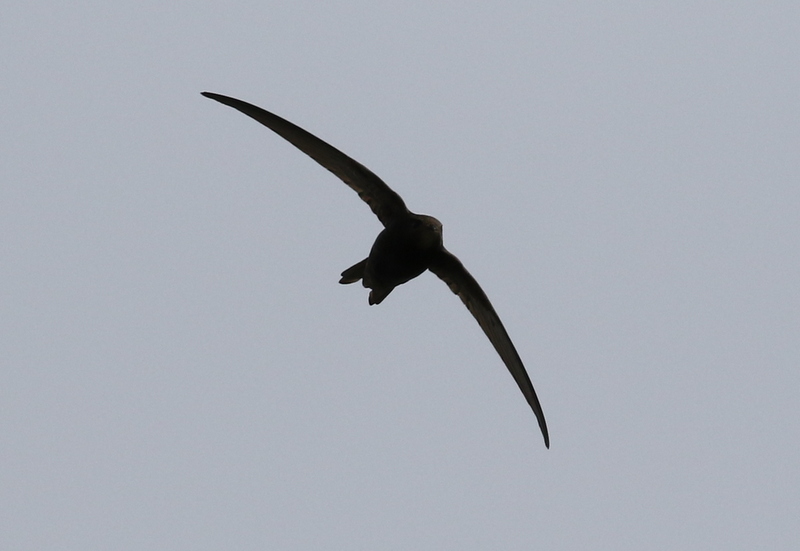 Swift – there was a steady westward passage today
Swift – there was a steady westward passage today
We could hear Chiffchaff and Common Whitethroat singing from the bushes, but they were keeping tucked down out of the wind today, and there was no sign of any Turtle Doves at first. We walked slowly along to the west end and we were almost at the golf course when we heard one purring briefly as we approached, just audible over the wind. We walked down to where we thought it had been, but it had gone quiet. There were lots of Wall Browns down in the grass in the lee of the bushes, enjoying a bit of sunshine.
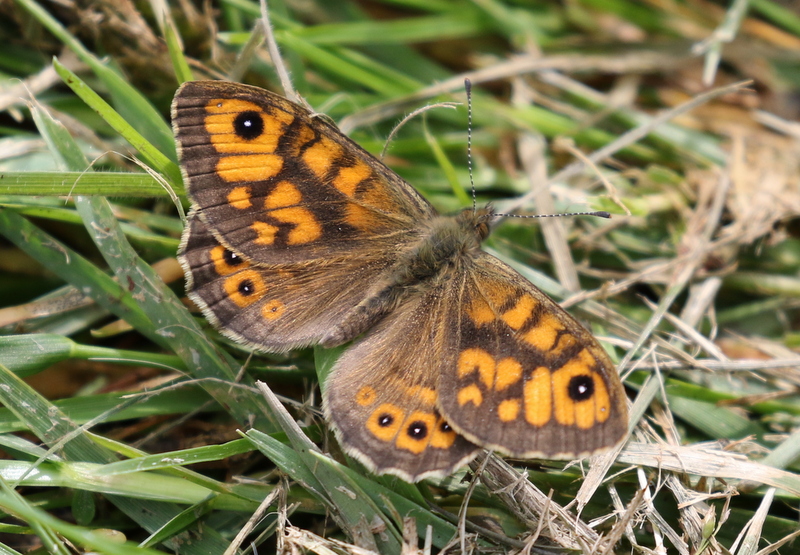 Wall Brown – we found lots down in the grass in the dunes
Wall Brown – we found lots down in the grass in the dunes
It seemed like we might be out of luck and we had just started to walk back when the Turtle Dove purred again briefly. This time we walked round the other side of the bushes and the next thing we knew it started purring in the bush right beside us. We still couldn’t see it as it was round on the other side, and we eventually just got a quick glimpse as it flew off. It really was too exposed and windy here, so we decided to give up and move on. On the way back to the car, a Cuckoo flew past over the paddocks.
Our next destination was Dersingham Bog. We thought we might find a little shelter from the wind here, and so it proved. At the bottom of the slope we found a family party of Stonechats. The pair of adults were flitting around between the low birch saplings, and as we watched we saw them fly across and feed a recently-fledged streaky juvenile Stonechat down in the heather.
While we were watching the Stonechats, we scanned the trees up on the hill beyond and in the very top of one of them we found a Tree Pipit. We got the scope on it and could see its well-marked face pattern, and the heavily streaked breast contrasting with needle-fine streaking on the flanks. It dropped down out of view, so we started to walk round for a closer look.
We hadn’t gone far when a pair of Woodlarks flew overhead and dropped down into the heather at the base of the slope a short distance away. Through the scope, we had a great view of them as they walked through the grass and patches of cut bracken.
 Woodlark – a pair were feeding quietly on bare ground at the base of the slope
Woodlark – a pair were feeding quietly on bare ground at the base of the slope
We walked round, past where the Tree Pipit had been singing earlier, but there was no sign of it. At the top of the hill the other side, we found ourselves out in the wind, so we decided to double back the way we had come. On the way, we heard the Tree Pipit singing and saw it land in one of the trees again. This time, we got a much better view as it perched on a branch singing, before it dropped down over the ridge out of view. It was great to hear it too, as singing Tree Pipits are so much rarer in North Norfolk now than they used to be. On our way back to the car, we stopped to watch a Roe Deer walking through the bracken. The Tree Pipit was in a different tree, much more distant again now, but we could still hear it singing away.
We had lunch back in the car park and then set off for Titchwell, our destination for the afternoon. We cut the corner off, going inland cross-country, looking for Grey Partridges. Unusually, there was no sign of any today until we got almost back to Choseley. Then we came face to face with a male Grey Partridge walking down the middle of the road towards us! We had a quick stop by the barns, but it was very windy up here now and there was no sign of any Corn Buntings. A smart male Yellowhammer landed briefly on the concrete.
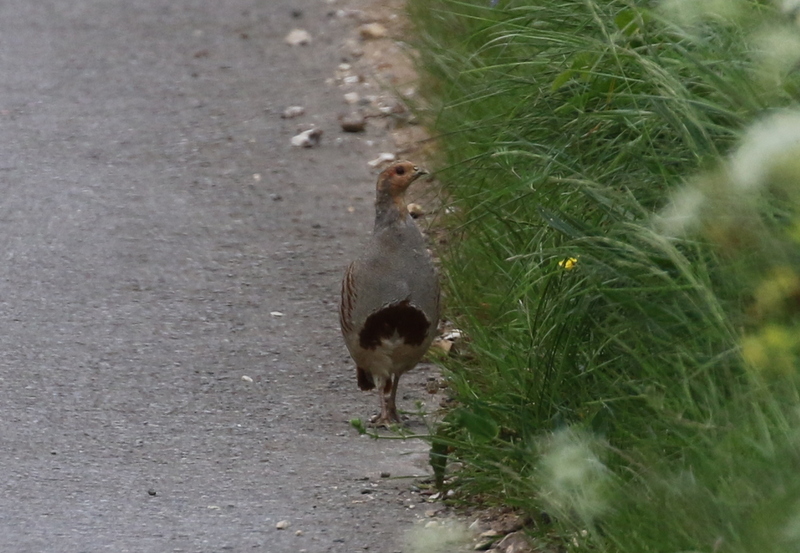 Grey Partridge – walking down the road near Choseley
Grey Partridge – walking down the road near Choseley
Round at Titchwell, we walked straight out onto the reserve. A Robin by the visitor centre was probably too full of crumbs from the picnic tables to take any interest in the mealworms proffered by one of the group!
As we made our way along the main path by the reedbed, we could hear a Reed Warbler singing close by. We could just see it perched on a curving reed stem, so we got it in the scope and watched it singing away. Very helpfully, it then climbed up the reeds into full view – great stuff. A little further along, we heard a Sedge Warbler too, which was a great opportunity to stop and talk about the differences between these two often confused species. A Cetti’s Warbler shouting from the reedbed was less of an identification challenge!
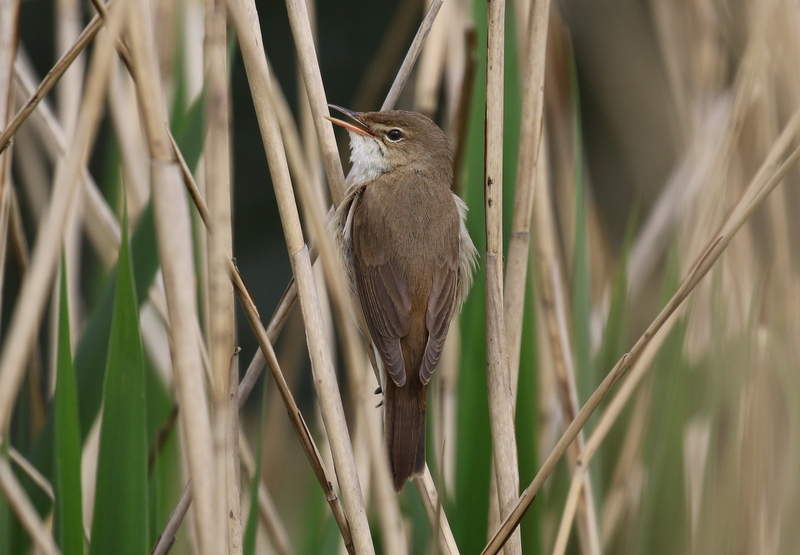 Reed Warbler – singing by the main path at Titchwell
Reed Warbler – singing by the main path at Titchwell
A Cuckoo was calling somewhere out across the reeds as we walked out. We stopped by the reedbed pool, but there were not many ducks on here today. We were however treated to repeated Bearded Tits flybys. Firstly, a male Bearded Tit zoomed low over the water and disappeared into the reeds. A short while later it flew back the other way. It repeated this procedure a couple of times, until we had all had a good look at him. A female Bearded Tit then flew out of the reeds and disappeared off behind the bushes in the direction of Fen Hide and the next thing we knew the male went on a long flight in that direction too. It is never normally a good idea to go looking for Bearded Tits on a windy day, so we were doubly lucky with their performance today.
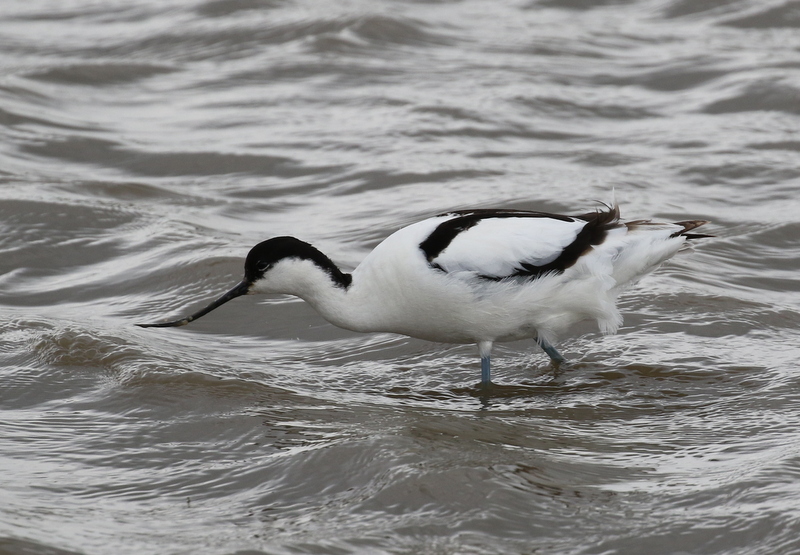 Avocet – showing well as usual
Avocet – showing well as usual
Right in front of Island Hide, a pair of Shelduck were feeding in the sticky mud. There were several Avocets here as usual too. A single White Wagtail was feeding out with several Pied Wagtails still.
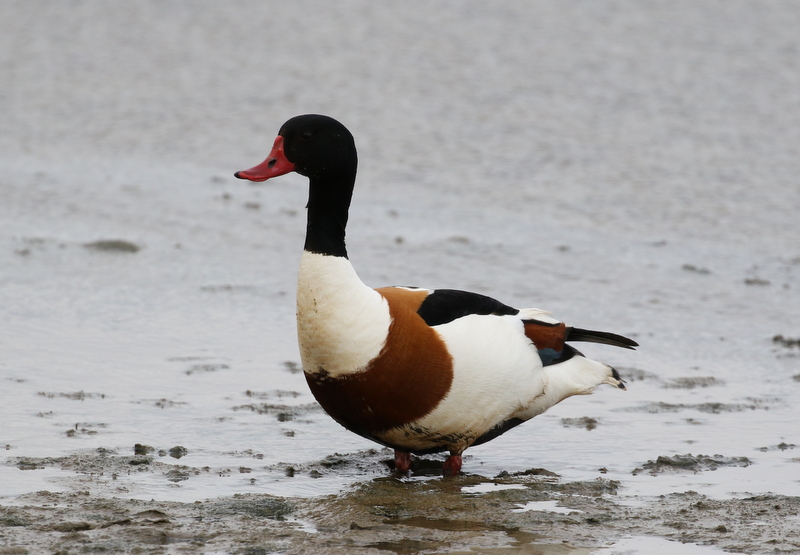 Shelduck – a pair were feeding in front of Island Hide
Shelduck – a pair were feeding in front of Island Hide
There were a few more waders on the Freshmarsh today. A large group of Oystercatcher were loafing around in the water and were joined by a single Curlew. Five Black-tailed Godwits were feeding between the islands. A flock of around twenty Turnstone flew in to bathe and then up onto one of the low islands to preen. Several of them are now in their stunning summer plumage, with extensive bright rufous feathering in the upperparts and white faces.
 Turnstones – several are now in stunning summer plumage
Turnstones – several are now in stunning summer plumage
Eventually we found the Little Stint, creeping around the flooded grassy islands over towards Parrinder Hide. When a Lapwing walked past, we could see just how tiny it was. We had seen a distant Little Ringed Plover over that side too, but then one appeared on the mud right in front of the hide. We could see its golden eyering so clearly now. Then from back up on the main path it was even closer. It was running around feeding, stopping to tap a foot on the mud, presumably to try to bring worms or other invertebrates to the surface.
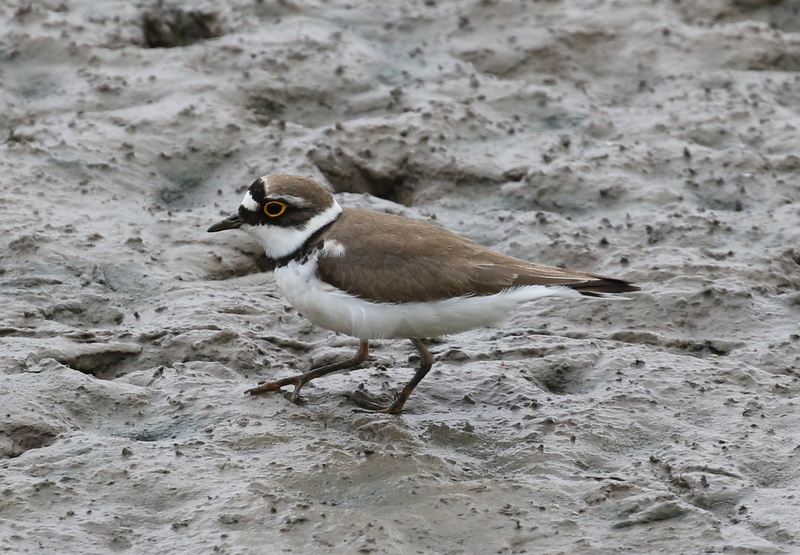 Little Ringed Plover – showed very well from the Main Path
Little Ringed Plover – showed very well from the Main Path
On the approach to Parrinder Hide, we could hear the Bittern booming. Even on the other side of the freshmarsh on such a windy day, it was clearly audible. From inside the hide, we could see the Little Stint much closer now. A smart summer plumaged bird, with bright rusty fringes to its upperparts and rusty feathering around the face. A Spoonbill flew past too, but unfortunately those standing up with the scopes behind the seats missed it as those sitting down didn’t say anything until it had passed.
 Little Stint – better views from Parrinder Hide
Little Stint – better views from Parrinder Hide
Some grey clouds came over but went through quickly without dropping any rain, so we decided to brave the wind and head out to the beach. The Volunteer Marsh was rather quiet again, apart from a stunning summer plumage Grey Plover on the side of the channel at the far end. Another was on the Tidal Pools.
The sea has been very quiet recently, with most of the seaduck long since having departed, so a single Common Scoter close inshore was most welcome. Even better, as we scanned across we found two cracking drake Common Eider on the sea too, the first we have seen here this year. We got them in the scope and had a good look at them – beautiful birds. Then further over still, we found a single Great Crested Grebe out on the sea as well.
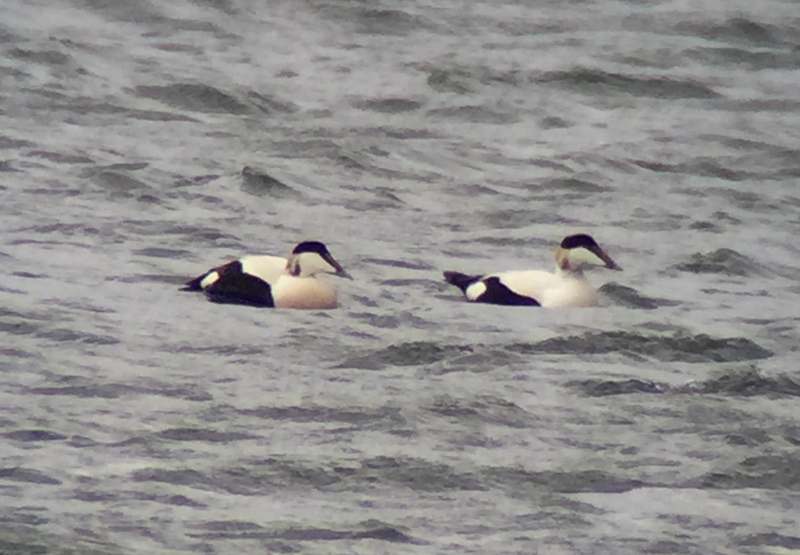 Eider – these two stunning drakes were on the sea today
Eider – these two stunning drakes were on the sea today
There were lots of Sandwich Terns fishing offshore and scanning through them we found a single distant Little Tern too. On the tideline, we could see a couple of flocks of roosting Oystercatcher and a few Sanderling running in and out of the waves. Then more Sanderling flew in to join them and in amongst them we could see a single black-bellied Dunlin.
 Common Scoter – flew in over the beach to the Tidal Pools
Common Scoter – flew in over the beach to the Tidal Pools
We were just thinking about leaving when the Common Scoter suddenly flew straight towards us, in over beach. It appeared to go down just behind the dunes, and when we started to walk out there it was on one of the islands on the Tidal Pools. It looked very odd, standing upright and preening, and distinctly out of place for a seaduck on here. It was a male, as evidenced by the mostly black plumage and yellow stripe down the top of the bill, but a young one, with lots of retained brown feathering still and a mottled belly.
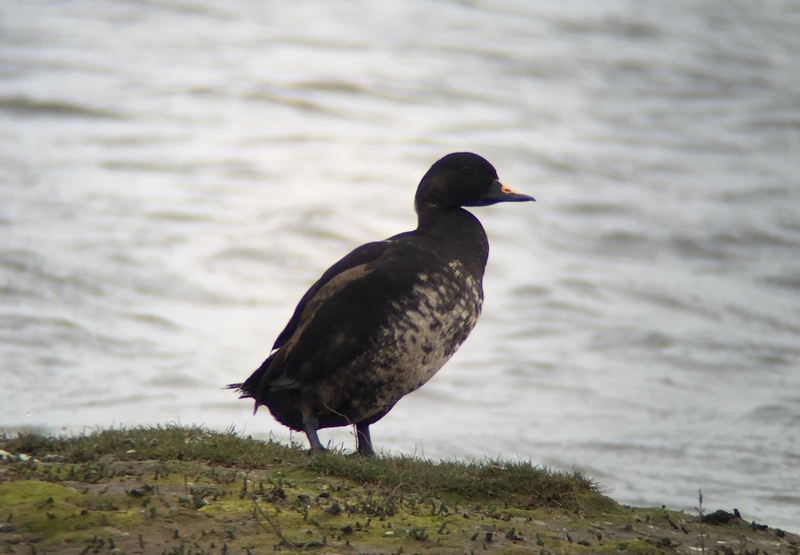 Common Scoter – landed on one of the islands to preen
Common Scoter – landed on one of the islands to preen
There were still more things to see on the way. Back on the freshmarsh, two Little Terns dropped in to bathe before landing on one of the islands to preen. They dropped in conveniently close to a couple of Common Terns, giving a great side by side comparison and highlighting just how small they really are. A pair of Red-crested Pochard flew in to the front of the reedbed pool, the drake looking especially smart still with his bright red bill and yellow-orange punk haircut. And as we were almost back, a Cuckoo flew out of the trees and away across the saltmarsh towards the dunes.
As a consequence of all the excitement, we were later back to the car than planned, but it had been well worth it, and a great way to round off the day.
















